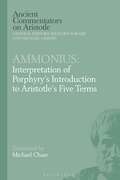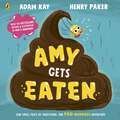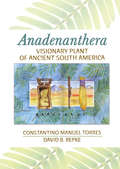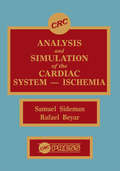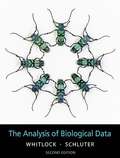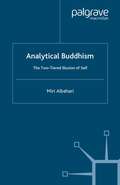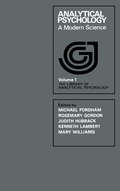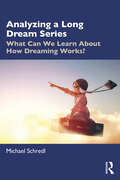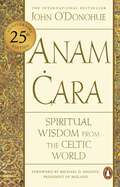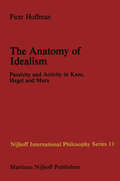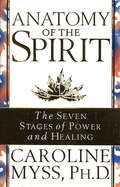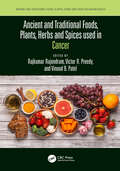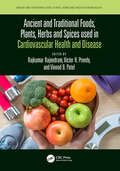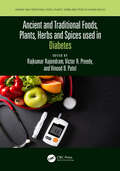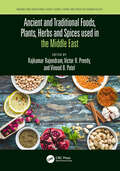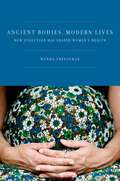- Table View
- List View
Ammonius: Interpretation of Porphyry’s Introduction to Aristotle’s Five Terms (Ancient Commentators on Aristotle)
by Michael ChaseOne of his six introductions to philosophy, widely used by students in Alexandria, Ammonius' lecture on Porphyry was recorded in writing by his students in the commentary translated here. Along with five other types of introductions (three of which are translated in the Ancient Commentators on Aristotle volume Elias and David: Introductions to Philosophy with Olympiodorus: Introduction to Logic) it made Greek philosophy more accessible to other cultures. These introductions became standard in Ammonius' school and included a popular set of five or more definitions of philosophy, some of them drawn from commentaries on quite different works.Ammonius' lecture expounded the most celebrated and discussed previous introduction written by Porphyry 200 years earlier, which was devoted to five main technical terms of Aristotle's logic. Ammonius was sympathetic to Porphyry because they both sought to harmonise the views of Plato and Aristotle with each other, arguing in different ways that the two philosophers did not disagree about the nature of universals. Porphyry's introduction was a hugely influential work for centuries after its composition, and this commentary by Ammonius served to maintain its position at the centre of later schools of philosophy.This English translation of Ammonius' work is the latest volume in the Ancient Commentators on Aristotle series and makes this philosophical work accessible to a modern readership. The translation is accompanied by an introduction, comprehensive commentary notes, bibliography, glossary of translated terms and a subject index.
Amnesia: Clinical, Psychological and Medicolegal Aspects
by C. W. M. Whitty O. L. ZangwillAmnesia: Clinical, Psychological and Medicolegal Aspects, 2nd Edition explores the clinical, psychological, and medicolegal aspects of amnesia. Experimental studies of the organic amnesic syndrome are presented and memory disorders associated with electroconvulsive therapy (ECT) are described. The role of amnesia in cerebral disease, the neuropathology of amnesic states, and psychogenic memory loss are also considered. This book is comprised of 11 chapters and begins with a discussion on experimental studies of the organic amnesic syndrome, along with certain associated studies of normal memory. The reader is then introduced to the link between amnesia and cerebral pathology; transient global amnesia and its clinical manifestations; the amnesic syndrome and its relation to Korsakoff syndrome; traumatic amnesia; amnesias of temporal lobe origin; and memory disorders following ECT. A neuropathological examination of the human brain in cases of amnesia is presented, and examples of the psychopathology of memory are provided. The final chapter analyzes amnesia from a medicolegal point of view. This monograph will be of interest to clinicians, neurologists, psychiatrists, psychopathologists, psychologists, and medicolegal practitioners.
Amy Gets Eaten
by Adam KayThe first-ever picture book from Adam Kay and Henry Paker.This is the hilarious (and admittedly a tiny bit gross) tale of Amy, a small piece of sweetcorn who is eaten by Noah, a medium-sized boy. The story follows Amy on her funny, gooey and anatomically-accurate adventure through the human body as she discovers lots of facts about digestion. (It's fair to say that parents might learn a little bit too.)Praise for Kay's Anatomy:'An enjoyably gross look at the human body. Hours of gruesome fun guaranteed' i'Like listening to a teacher who makes pupils fall about' Sunday Times'Totally brilliant!' Jacqueline Wilson'Fun and informative' Malorie Blackman'Very funny - this exciting book is bound to inspire the next generation of medics' Sunday ExpressPraise for Kay's Marvellous Medicine:'A ridiculously funny read that will delight, gross out and educate all at the same time' Independent'Educational and entertaining. It should be on the national curriculum!' Harry Hill'Completely marvellous and very funny' BookTrust
Anadenanthera: Visionary Plant of Ancient South America
by Constantino M Torres David B RepkeA multidisciplinary study of pre-Columbian South America-centering on the psychoactive plant genus AnadenantheraAs cultures formed and evolved in pre-Columbian South America, Anadenanthera became one of the most widely used shamanic inebriants. Anadenanthera: Visionary Plant of Ancient South America is more than a comprehensive reference on shamanic visionary substances; it is a useful tool for archeologists and pre-Columbian art historians. This thorough book examines the ritual and cultural use of Anadenanthera from prehistory to the present, along with its botany, chemistry, pharmacology, anthropology, and archeology.The earliest evidence for the use of psychoactive plants in South America is provided by remains of seeds and pods recovered from archeological sites four millennia old. Various preparations were derived from it with the intent of being a shamanic inebriant. Inhaled through the nose, smoked in pipes or as cigars, and prepared in fermented drinks, Anadenanthera served a central role in the cultural development of indigenous societies in South America. Anadenanthera: Visionary Plant of Ancient South America explores the full spectrum of information gleaned from research, covering numerous archeological sites in the Andean region, as well as discussing Amazonian shamanic rituals and lore. Analyses of the artistic expressions within the decorations of associated ceremonial paraphernalia such as ritual snuffing tubes and snuff trays are included. The text is richly illustrated with photographs and images of decorated ritual implements, and provides a comprehensive bibliography.Anadenanthera: Visionary Plant of Ancient South America explores: botanical aspects, taxonomy, and geographical distribution of Anadenanthera ethnographical, historical, and traditional aspects of Anadenanthera use chemical and pharmacological investigations of the genus and the various visionary preparations derived from it-with emphasis on the biologically active constituents theories of the mechanisms of action of the active tryptamines and carboline alkaloids comparisons of wood anatomy, morphology, and percentage of alkaloid content evaluation of stylistic and iconographic traitsAnadenanthera: Visionary Plant of Ancient South America is a thorough, useful resource for archeologists, anthropologists, chemists, researchers, pre-Columbian art historians, and any layperson interested in pre-Columbian art, archeology, or visionary plants.
Anadenanthera: Visionary Plant of Ancient South America
by Constantino M Torres David B RepkeA multidisciplinary study of pre-Columbian South America-centering on the psychoactive plant genus AnadenantheraAs cultures formed and evolved in pre-Columbian South America, Anadenanthera became one of the most widely used shamanic inebriants. Anadenanthera: Visionary Plant of Ancient South America is more than a comprehensive reference on shamanic visionary substances; it is a useful tool for archeologists and pre-Columbian art historians. This thorough book examines the ritual and cultural use of Anadenanthera from prehistory to the present, along with its botany, chemistry, pharmacology, anthropology, and archeology.The earliest evidence for the use of psychoactive plants in South America is provided by remains of seeds and pods recovered from archeological sites four millennia old. Various preparations were derived from it with the intent of being a shamanic inebriant. Inhaled through the nose, smoked in pipes or as cigars, and prepared in fermented drinks, Anadenanthera served a central role in the cultural development of indigenous societies in South America. Anadenanthera: Visionary Plant of Ancient South America explores the full spectrum of information gleaned from research, covering numerous archeological sites in the Andean region, as well as discussing Amazonian shamanic rituals and lore. Analyses of the artistic expressions within the decorations of associated ceremonial paraphernalia such as ritual snuffing tubes and snuff trays are included. The text is richly illustrated with photographs and images of decorated ritual implements, and provides a comprehensive bibliography.Anadenanthera: Visionary Plant of Ancient South America explores: botanical aspects, taxonomy, and geographical distribution of Anadenanthera ethnographical, historical, and traditional aspects of Anadenanthera use chemical and pharmacological investigations of the genus and the various visionary preparations derived from it-with emphasis on the biologically active constituents theories of the mechanisms of action of the active tryptamines and carboline alkaloids comparisons of wood anatomy, morphology, and percentage of alkaloid content evaluation of stylistic and iconographic traitsAnadenanthera: Visionary Plant of Ancient South America is a thorough, useful resource for archeologists, anthropologists, chemists, researchers, pre-Columbian art historians, and any layperson interested in pre-Columbian art, archeology, or visionary plants.
Analogical Reasoning: Perspectives of Artificial Intelligence, Cognitive Science, and Philosophy (Synthese Library #197)
by David H. HelmanIn the last few years, there has been an enormous amount of activity in the study of analogy and metaphor. This is partly because of an interest of artificial intelligence researchers in simulating learning processes using analogy. It also arises from critical examinations of standard theories in the philosophy of language, with their inbuilt literal/meta phoric distinction. This volume consists of recent previously unpub lished work in this area, with a particular emphasis upon the role of analogies in reasoning and, more generally, their role in thought and language. The papers are contributed by philosophers, computer scientists, cognitive scientists and literary critics. Researchers in these fields whose focus is the study of analogy and metaphor will find much of interest in this volume. These essays can also serve as an introduction to some of the major approaches taken in the investigation of analogy. As noted, this volume brings together the work of researchers in several different disciplines. The various approaches taken with respect to the understanding of analogy tend to be rather different, however, the articles suggest a common conclusion. Analogy and metaphor pervade thought and language; their close investigation thus constitutes a valuable contribution to our understanding of persons. DAVID H. HELMAN Case Western Reserve University vii PART I CONCEPTUAL AND CATEGORICAL THEORIES OF ANALOGICAL UNDERSTANDING MARK TURNER CATEGORIES AND ANALOGIES I want to pursue the following claims: The way we categorize helps explain the way we recognize a statement as an analogy.
Analysis and Simulation of the Cardiac System Ischemia
by Rafael Beyar Samuel SidemanOver thiry-five experts contribute to this publication about the various interactions and interrelationships of the parameters which affect the normal and ischemic heart. Mechanical aspects related to the global and regional function of the heart are discussed. Coronary perfusion of the ischemic heart is considered, with emphasis on the effects of reperfusion. Electrical activation, formation of arrhythmias, and the effects of ischemia or ionic transport in the myocardium are presented. Metabolic aspects of the ischemic heart, including calcium transport, are also explained.
Analysis and Simulation of the Cardiac System Ischemia
by Rafael Beyar Samuel SidemanOver thiry-five experts contribute to this publication about the various interactions and interrelationships of the parameters which affect the normal and ischemic heart. Mechanical aspects related to the global and regional function of the heart are discussed. Coronary perfusion of the ischemic heart is considered, with emphasis on the effects of reperfusion. Electrical activation, formation of arrhythmias, and the effects of ischemia or ionic transport in the myocardium are presented. Metabolic aspects of the ischemic heart, including calcium transport, are also explained.
The Analysis of Biological Data, Second Edition
by Michael C. Whitlock Dolph SchluterThis second edition textbook teaches modern methods of statistics through the use of fascinating biological and medical case studies. The clear and engaging writing and practical perspective allows students to understand the analytical process behind biological data. Through the use of real world biological examples, biologists and health professionals can learn statistics in an essential manner.
Analytical Buddhism: The Two-tiered Illusion of Self
by M. AlbahariDoes the self - a unified, separate, persisting thinker/owner/agent - exist? Drawing on Western philosophy, neurology and Theravadin Buddhism, this book argues that the self is an illusion created by a tier of non-illusory consciousness and a tier of desire-driven thought and emotion, and that separateness underpins the self's illusory status.
Analytical Psychology: A Modern Science
by Michael Fordham Rosemary Gordon Judith HubbackAnalytical Psychology: A Modern Science discusses the fundamental concepts of analytical psychology and presents clinical studies. The book is comprised of 14 chapters that are organized into two parts. The first part covers the basic concepts and theoretical basis of analytical psychology. Concepts such as symbols, archetypes, and ego are covered in the first part. The text also covers the importance of analyzing childhood. Next, the book presents some clinical studies. Cases such as the incapacity to imagine and sense of time are discussed. The text will be of great interest to students, researchers, and practitioners of psychology, particularly those who wish to specialize in analytical psychology.
Analyzing a Long Dream Series: What Can We Learn About How Dreaming Works?
by Michael SchredlAnalyzing a Long Dream Series provides an extraordinary insight into the richness and variability of dreams, considering over 12,000 dreams that have been recorded for more than 30 years. Internationally recognized dream scientist Michael Schredl opens up his own personal dream series, offering a unique window into the interplay between waking life and dreaming. The book considers a huge range of dream topics, including family, friends, schoolmates, colleagues, erotic dreams, alongside the appearance of everyday objects. It also discusses rarer themes such as pain perception, temperature perception, and typical dreams about toilets, exams, and teeth. As the author is both the dreamer and the researcher, questions like why we dream about topics we have never experienced in waking life – for example, about the pain of being shot in the stomach – can be addressed, shedding light on the creative nature of dreams. The in-depth analyses provided in this book attempt to answer the field's most profound questions: why do we dream every night, and why do we dream in such creative ways about the issues that are important to us in waking life? The dreams analyzed question existing dream theories such as simulation theories, and the author proposes a function of recalled dreams for creative problem solving and provides ideas for future research. This fascinating book is an essential read for all dream researchers and students of the psychology of dreams.
Analyzing a Long Dream Series: What Can We Learn About How Dreaming Works?
by Michael SchredlAnalyzing a Long Dream Series provides an extraordinary insight into the richness and variability of dreams, considering over 12,000 dreams that have been recorded for more than 30 years. Internationally recognized dream scientist Michael Schredl opens up his own personal dream series, offering a unique window into the interplay between waking life and dreaming. The book considers a huge range of dream topics, including family, friends, schoolmates, colleagues, erotic dreams, alongside the appearance of everyday objects. It also discusses rarer themes such as pain perception, temperature perception, and typical dreams about toilets, exams, and teeth. As the author is both the dreamer and the researcher, questions like why we dream about topics we have never experienced in waking life – for example, about the pain of being shot in the stomach – can be addressed, shedding light on the creative nature of dreams. The in-depth analyses provided in this book attempt to answer the field's most profound questions: why do we dream every night, and why do we dream in such creative ways about the issues that are important to us in waking life? The dreams analyzed question existing dream theories such as simulation theories, and the author proposes a function of recalled dreams for creative problem solving and provides ideas for future research. This fascinating book is an essential read for all dream researchers and students of the psychology of dreams.
Anam Cara: Spiritual Wisdom from the Celtic World
by John O'DonohueWhen St Patrick came to Ireland in the 5th century AD, he encountered the Celtic people and a flourishing spiritual tradition that had already existed for thousands of years. He also discovered that where the Christians worshipped one God, the Celts had many and found divinity all around them: in the rivers, hills, sea and sky. The ancient Celtic reverence for the spirit in all things survives today - a vibrant legacy of mystical wisdom that is unique in the Western world. Now, in this exquisite book, Irish poet and schollar John O'Donohue shares with us the secrets of this ancient world. Using authentic Irish prayers and blessings, he reveals the treasures that lie hidden within your own soul and the 'secret divinity' in your relationships. As he traces the cycles of life and nature, he draws from the holy waters of Ireland's spiritual heritage to lead you to a place where your heart can be healed and nourished. It is a place wher you will disocer your own anam cara, your true 'soul friend'.
The Anatomy of Idealism: Passivity and Activity in Kant, Hegel and Marx (Nijhoff International Philosophy Series #11)
by P. HoffmanIn its attempt to come to grips with the nature of the human mind idealism employs such terms as "pure self," "transcendental apperception," "pure con sciousness" and so on. What do these terms mean? What do they refer to? Pro visionally, at least, the following answer could be satisfying: such and similar expressions are purported to capture a very special quality of human mind, a quality due to which man is not simply a part of nature, but a being capable of knowing and acting according to principles governing the spiritual realm. In the first chapter of the present study the author attempts to bring the idea of "pure Ego" down to earth. By analyzing Kant's concept of pure appercep tion - the ancestor of all similar notions in the history of modern and contem porary idealism - the author concludes that certain functions and capacities attributed to pure apperception by Kant himself imply the rejection of the idealistic framework and the necessity to "naturalize" the idea of pure self. In other words - and Kant's claims to the contrary notwithstanding - pure ap perception cannot be conceived as superimposed upon man viewed as a part of nature, as a feeling and a sensing being. The referent, as it were, of the expres sion "pure self' turns out to be something much more familiar to us - a human organism, with all its needs, drives and dispositions.
Anatomy Of The Spirit: The Seven Stages Of Power And Healing (Orient Express Ser.)
by Caroline MyssAnatomy of the Spirit is the first book to unify Eastern and Western spiritual healing into a programme for physical healing and personal power. In this breakthrough view of mind, body and spirit, Caroline Myss demonstrates that the seven stages through which everyone must pass in the search for consciousness and spiritual maturity are the same in all traditions and are also the same seven stages for healing.During her many years of research into the power centres of the body, Myss has uncovered strong evidence that each illness we develop corresponds to a very specific pattern of emotional and psychological stress and that certain beliefs and attitudes influence corresponding areas of the human body. For example, fears regarding financial stress affect the health of the lower back; emotional barriers to experiencing love undermine the health of the heart. A strong need to control others or your environment influences the health of the sexual area of your body. Caroline also discusses in depth why people do not heal and the reasons why we often find ourselves in difficult circumstances that never seem to change.
Ancient and Traditional Foods, Plants, Herbs and Spices used in Cancer (Ancient and Traditional Foods, Plants, Herbs and Spices in Human Health)
by Rajkumar Rajendram Victor R. Preedy Vinood B. PatelThe use of different foods, herbs, and spices to treat or prevent disease has been recorded for thousands of years. Egyptian papyrus, hieroglyphics and ancient texts from the Middle East have described the cultivation and preparations of herbs and botanicals to “cure the sick.” There are even older records from China and India. Some ancient scripts describe the use of medicinal plants which have never been seen within European cultures. Indeed, all ancient civilizations have pictorial records of different foods, herbs, and spices being used for medical purposes. However, there are fundamental questions pertaining to the scientific evidence for the use of these agents or their extracts in modern medicine. There have been considerable advances in scientific techniques over the last few decades. These have been used to examine the composition and applications of traditional cures. Modern science has also seen the investigation of herbs, spices and botanicals beyond their traditional usage. For example, plants which have been used for “digestion” or “medical ills” since time immemorial are now being investigated for anti-cancer properties or their toxicity, using high throughput screening. Techniques also include molecular biology, cellular biochemistry, physiology, endocrinology and even medical imaging. However, much of the material relating to the scientific basis or applications of traditional foods, herbs, spices and botanicals is scattered among various sources. The widespread applicability of foods or botanicals is rarely described and cautionary notes on toxicity are often ignored. These questions are explored in Ancient and Traditional Foods, Plants, Herbs and Spices used in Cancer. Features · Provides an evidenced-based approach in describing usage and applications of traditional foods and botanicals in prevention and treatment of cancer · Contains chapters on biomedical research related to cancer studies · Discusses extraction and analysis of active agents, in vitro studies, pre-clinical investigations in animals, and clinical studies · Bridges modern day sciences with historical backgrounds related to foods and plants With contributions from leading international experts including those from world renowned institutions, this book is a reference for oncologists, physicians, health scientists, healthcare workers, pharmacologists, and research scientists.
Ancient and Traditional Foods, Plants, Herbs and Spices used in Cancer (Ancient and Traditional Foods, Plants, Herbs and Spices in Human Health)
The use of different foods, herbs, and spices to treat or prevent disease has been recorded for thousands of years. Egyptian papyrus, hieroglyphics and ancient texts from the Middle East have described the cultivation and preparations of herbs and botanicals to “cure the sick.” There are even older records from China and India. Some ancient scripts describe the use of medicinal plants which have never been seen within European cultures. Indeed, all ancient civilizations have pictorial records of different foods, herbs, and spices being used for medical purposes. However, there are fundamental questions pertaining to the scientific evidence for the use of these agents or their extracts in modern medicine. There have been considerable advances in scientific techniques over the last few decades. These have been used to examine the composition and applications of traditional cures. Modern science has also seen the investigation of herbs, spices and botanicals beyond their traditional usage. For example, plants which have been used for “digestion” or “medical ills” since time immemorial are now being investigated for anti-cancer properties or their toxicity, using high throughput screening. Techniques also include molecular biology, cellular biochemistry, physiology, endocrinology and even medical imaging. However, much of the material relating to the scientific basis or applications of traditional foods, herbs, spices and botanicals is scattered among various sources. The widespread applicability of foods or botanicals is rarely described and cautionary notes on toxicity are often ignored. These questions are explored in Ancient and Traditional Foods, Plants, Herbs and Spices used in Cancer. Features · Provides an evidenced-based approach in describing usage and applications of traditional foods and botanicals in prevention and treatment of cancer · Contains chapters on biomedical research related to cancer studies · Discusses extraction and analysis of active agents, in vitro studies, pre-clinical investigations in animals, and clinical studies · Bridges modern day sciences with historical backgrounds related to foods and plants With contributions from leading international experts including those from world renowned institutions, this book is a reference for oncologists, physicians, health scientists, healthcare workers, pharmacologists, and research scientists.
Ancient and Traditional Foods, Plants, Herbs and Spices used in Cardiovascular Health and Disease (Ancient and Traditional Foods, Plants, Herbs and Spices in Human Health)
by Vinood B. Patel Victor R. Preedy Rajkumar RajendramThe use of different foods, herbs, and spices to treat or prevent disease has been recorded for thousands of years. Egyptian papyrus, hieroglyphics and ancient texts from the Middle East have described the cultivation and preparations of herbs and botanicals to "cure the sick". There are even older records from China and India. Some ancient scripts describe the use of medicinal plants which have never been seen within European cultures. Indeed, all ancient civilizations have pictorial records of different foods, herbs, and spices being used for medical purposes. However, there are fundamental issues pertaining to the scientific evidence for the use of these agents or their extracts in modern medicine. There have been considerable advances in scientific techniques over the last few decades. These have been used to examine the composition and applications of traditional cures. Modern science has also seen the investigation of herbs, spices and botanicals beyond their traditional usage. For example, plants which have been used for “digestion” or “medical ills” since time immemorial are now being investigated for anti-cancer properties or their toxicity, using high throughput screening. Techniques also include molecular biology, cellular biochemistry, physiology, endocrinology and even medical imaging. However, much of the material relating to the scientific basis or applications of traditional foods, herbs, spices and botanicals is scattered among various sources. The widespread applicability of foods or botanicals are rarely described and cautionary notes on toxicity are often ignored. These issues are explored in Ancient and Traditional Foods, Plants, Herbs and Spices used in Cardiovascular Health and Disease. Features: Investigates alternative healthcare paradigms that use traditional dietary foods, plant-derived materials, and extracts to treat cardiovascular diseases Provides information on diets, specific agents, and extracts Many chapters focus on plant-derived material, providing a historical background, uses, toxicity and cautionary notes and summary points With contributions from leading international experts, this book is useful for cardiologists, nutritionists, physicians, healthcare workers, food scientists and those working in the food industry, pharmacologists, and research scientists.
Ancient and Traditional Foods, Plants, Herbs and Spices used in Cardiovascular Health and Disease (Ancient and Traditional Foods, Plants, Herbs and Spices in Human Health)
The use of different foods, herbs, and spices to treat or prevent disease has been recorded for thousands of years. Egyptian papyrus, hieroglyphics and ancient texts from the Middle East have described the cultivation and preparations of herbs and botanicals to "cure the sick". There are even older records from China and India. Some ancient scripts describe the use of medicinal plants which have never been seen within European cultures. Indeed, all ancient civilizations have pictorial records of different foods, herbs, and spices being used for medical purposes. However, there are fundamental issues pertaining to the scientific evidence for the use of these agents or their extracts in modern medicine. There have been considerable advances in scientific techniques over the last few decades. These have been used to examine the composition and applications of traditional cures. Modern science has also seen the investigation of herbs, spices and botanicals beyond their traditional usage. For example, plants which have been used for “digestion” or “medical ills” since time immemorial are now being investigated for anti-cancer properties or their toxicity, using high throughput screening. Techniques also include molecular biology, cellular biochemistry, physiology, endocrinology and even medical imaging. However, much of the material relating to the scientific basis or applications of traditional foods, herbs, spices and botanicals is scattered among various sources. The widespread applicability of foods or botanicals are rarely described and cautionary notes on toxicity are often ignored. These issues are explored in Ancient and Traditional Foods, Plants, Herbs and Spices used in Cardiovascular Health and Disease. Features: Investigates alternative healthcare paradigms that use traditional dietary foods, plant-derived materials, and extracts to treat cardiovascular diseases Provides information on diets, specific agents, and extracts Many chapters focus on plant-derived material, providing a historical background, uses, toxicity and cautionary notes and summary points With contributions from leading international experts, this book is useful for cardiologists, nutritionists, physicians, healthcare workers, food scientists and those working in the food industry, pharmacologists, and research scientists.
Ancient and Traditional Foods, Plants, Herbs and Spices used in Diabetes (Ancient and Traditional Foods, Plants, Herbs and Spices in Human Health)
by Rajkumar Rajendram Victor R. Preedy Vinood B. PatelThe use of different foods, herbs, and spices to treat or prevent disease has been recorded for thousands of years. Egyptian papyrus, hieroglyphics and ancient texts from the Middle East have described the cultivation and preparations of herbs and botanicals to “cure the sick.” There are even older records from China and India. Some ancient scripts describe the use of medicinal plants which have never been seen within European cultures. Indeed, all ancient civilizations have pictorial records of different foods, herbs, and spices being used for medical purposes. However, there are fundamental issues pertaining to the scientific evidence for the use of these agents or their extracts in modern medicine. These issues are explored in Ancient and Traditional Foods, Plants, Herbs and Spices Used in Diabetes. Features · Investigates alternative healthcare paradigms that use traditional dietary foods, plant-derived materials, and extracts to treat diabetes · Describes scientific studies using modern day biomedical techniques · Provides information on diets, specific agents, extracts and resources. · Many chapters focus on plant-derived material, providing a historical background, uses, toxicity, and cautionary notes and summary points. There have been considerable advances in scientific techniques over the last few decades. These have been used to examine the composition and applications of traditional cures. Modern science has also seen the investigation of herbs, spices and botanicals beyond their traditional usage. Diabetes is one of the most common diseases worldwide, with over 400 million people with the illness. With chapter contributions by an international panel of contributors, this book is useful for researchers in the area of functional foods. Diabetologists, nutritionists, endocrinologists, healthcare workers, and pharmacologists will also find this book extremely valuable.
Ancient and Traditional Foods, Plants, Herbs and Spices used in Diabetes (Ancient and Traditional Foods, Plants, Herbs and Spices in Human Health)
The use of different foods, herbs, and spices to treat or prevent disease has been recorded for thousands of years. Egyptian papyrus, hieroglyphics and ancient texts from the Middle East have described the cultivation and preparations of herbs and botanicals to “cure the sick.” There are even older records from China and India. Some ancient scripts describe the use of medicinal plants which have never been seen within European cultures. Indeed, all ancient civilizations have pictorial records of different foods, herbs, and spices being used for medical purposes. However, there are fundamental issues pertaining to the scientific evidence for the use of these agents or their extracts in modern medicine. These issues are explored in Ancient and Traditional Foods, Plants, Herbs and Spices Used in Diabetes. Features · Investigates alternative healthcare paradigms that use traditional dietary foods, plant-derived materials, and extracts to treat diabetes · Describes scientific studies using modern day biomedical techniques · Provides information on diets, specific agents, extracts and resources. · Many chapters focus on plant-derived material, providing a historical background, uses, toxicity, and cautionary notes and summary points. There have been considerable advances in scientific techniques over the last few decades. These have been used to examine the composition and applications of traditional cures. Modern science has also seen the investigation of herbs, spices and botanicals beyond their traditional usage. Diabetes is one of the most common diseases worldwide, with over 400 million people with the illness. With chapter contributions by an international panel of contributors, this book is useful for researchers in the area of functional foods. Diabetologists, nutritionists, endocrinologists, healthcare workers, and pharmacologists will also find this book extremely valuable.
Ancient and Traditional Foods, Plants, Herbs and Spices used in the Middle East (Ancient and Traditional Foods, Plants, Herbs and Spices in Human Health)
by Rajkumar Rajendram Victor R. Preedy Vinood B. PatelThe use of different foods, herbs, and spices to treat or prevent disease has been recorded for thousands of years. Egyptian papyrus, hieroglyphics and ancient texts from the Middle East have described the cultivation and preparations of herbs and botanicals to “cure the sick.” There are even older records from China and India. Some ancient scripts describe the use of medicinal plants which have never been seen within European cultures. Indeed, all ancient civilizations have pictorial records of different foods, herbs, and spices being used for medical purposes. However, there are fundamental questions and issues pertaining to the scientific evidence for the use of these agents or their extracts in modern medicine. These issues are explored in Ancient and Traditional Foods, Plants, Herbs and Spices used in the Middle East. Features · Describes uses and applications of plant-based materials from different countries of the Middle East. · Each chapter has unique cross references to foods, herbs, spices and botanicals · Bridges molecular biology, physiology and medical sciences · Coverage includes herbal medicines, supplements, lifestyle patterns, nutrition, and plant-based diets · Each chapter describes usage and applications of traditional foods and botanicals; historical background; toxicity; cautionary notes; and summary points There have been considerable advances in scientific techniques over the last few decades. These have been used to examine the composition and applications of traditional cures. Modern science has also seen the investigation of herbs, spices and botanicals beyond their traditional usage. Written by international experts, this is an essential read for food researchers, food scientists, and nutritionists, researchers and health professionals with an interest in the potential therapeutic value of Middle Eastern food components. The book will also be of relevance to physicians and pharmacologists.
Ancient and Traditional Foods, Plants, Herbs and Spices used in the Middle East (Ancient and Traditional Foods, Plants, Herbs and Spices in Human Health)
The use of different foods, herbs, and spices to treat or prevent disease has been recorded for thousands of years. Egyptian papyrus, hieroglyphics and ancient texts from the Middle East have described the cultivation and preparations of herbs and botanicals to “cure the sick.” There are even older records from China and India. Some ancient scripts describe the use of medicinal plants which have never been seen within European cultures. Indeed, all ancient civilizations have pictorial records of different foods, herbs, and spices being used for medical purposes. However, there are fundamental questions and issues pertaining to the scientific evidence for the use of these agents or their extracts in modern medicine. These issues are explored in Ancient and Traditional Foods, Plants, Herbs and Spices used in the Middle East. Features · Describes uses and applications of plant-based materials from different countries of the Middle East. · Each chapter has unique cross references to foods, herbs, spices and botanicals · Bridges molecular biology, physiology and medical sciences · Coverage includes herbal medicines, supplements, lifestyle patterns, nutrition, and plant-based diets · Each chapter describes usage and applications of traditional foods and botanicals; historical background; toxicity; cautionary notes; and summary points There have been considerable advances in scientific techniques over the last few decades. These have been used to examine the composition and applications of traditional cures. Modern science has also seen the investigation of herbs, spices and botanicals beyond their traditional usage. Written by international experts, this is an essential read for food researchers, food scientists, and nutritionists, researchers and health professionals with an interest in the potential therapeutic value of Middle Eastern food components. The book will also be of relevance to physicians and pharmacologists.
Ancient Bodies, Modern Lives: How Evolution Has Shaped Women's Health
by Wenda Trevathan, Ph.D.Winner of the 2011 W.W. Howells Book Award of the American Anthropological Association How has bipedalism impacted human childbirth? Do PMS and postpartum depression have specific, maybe even beneficial, functions? These are only two of the many questions that specialists in evolutionary medicine seek to answer, and that anthropologist Wenda Trevathan addresses in Ancient Bodies, Modern Lives. Exploring a range of women's health issues that may be viewed through an evolutionary lens, specifically focusing on reproduction, Trevathan delves into issues such as the medical consequences of early puberty in girls, the impact of migration, culture change, and poverty on reproductive health, and how fetal growth retardation affects health in later life. Hypothesizing that many of the health challenges faced by women today result from a mismatch between how their bodies have evolved and the contemporary environments in which modern humans live, Trevathan sheds light on the power and potential of examining the human life cycle from an evolutionary perspective, and how this could improve our understanding of women's health and our ability to confront health challenges in more creative, effective ways.
